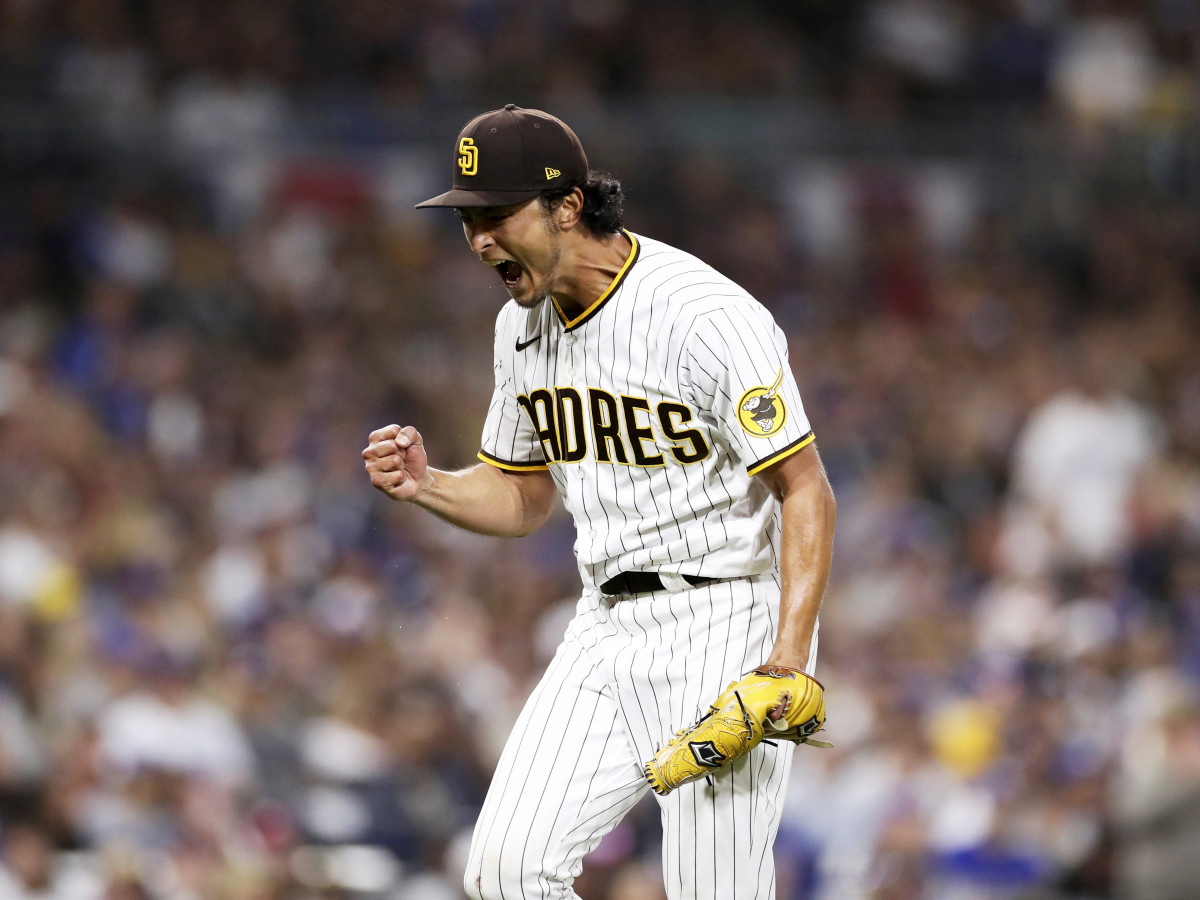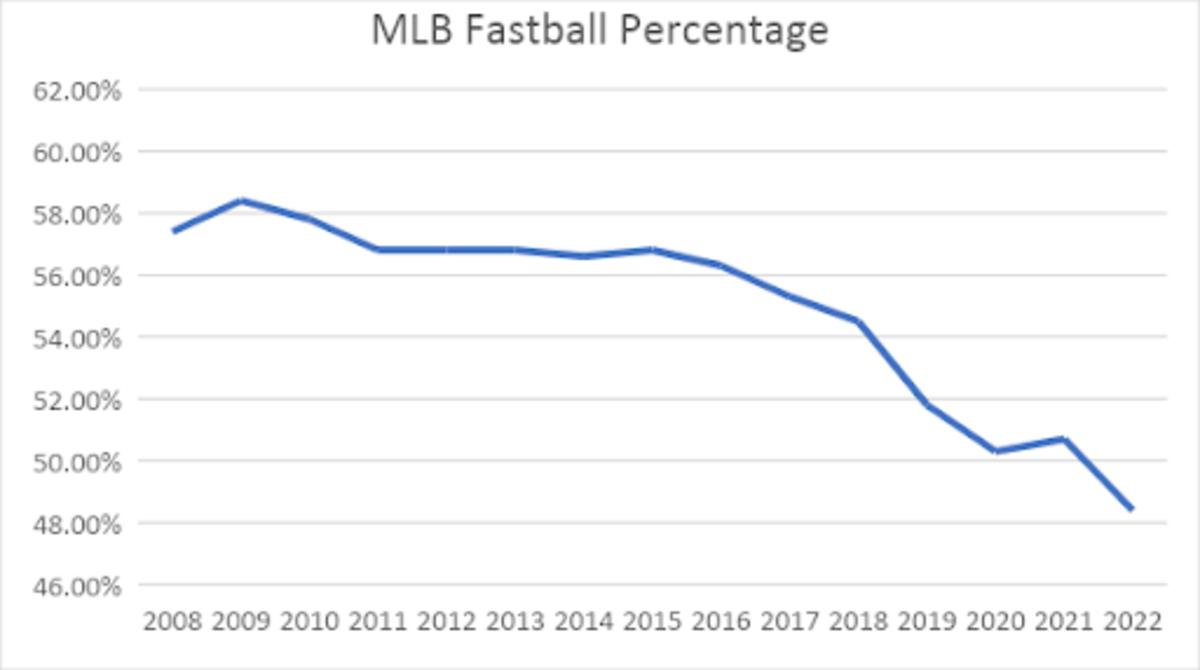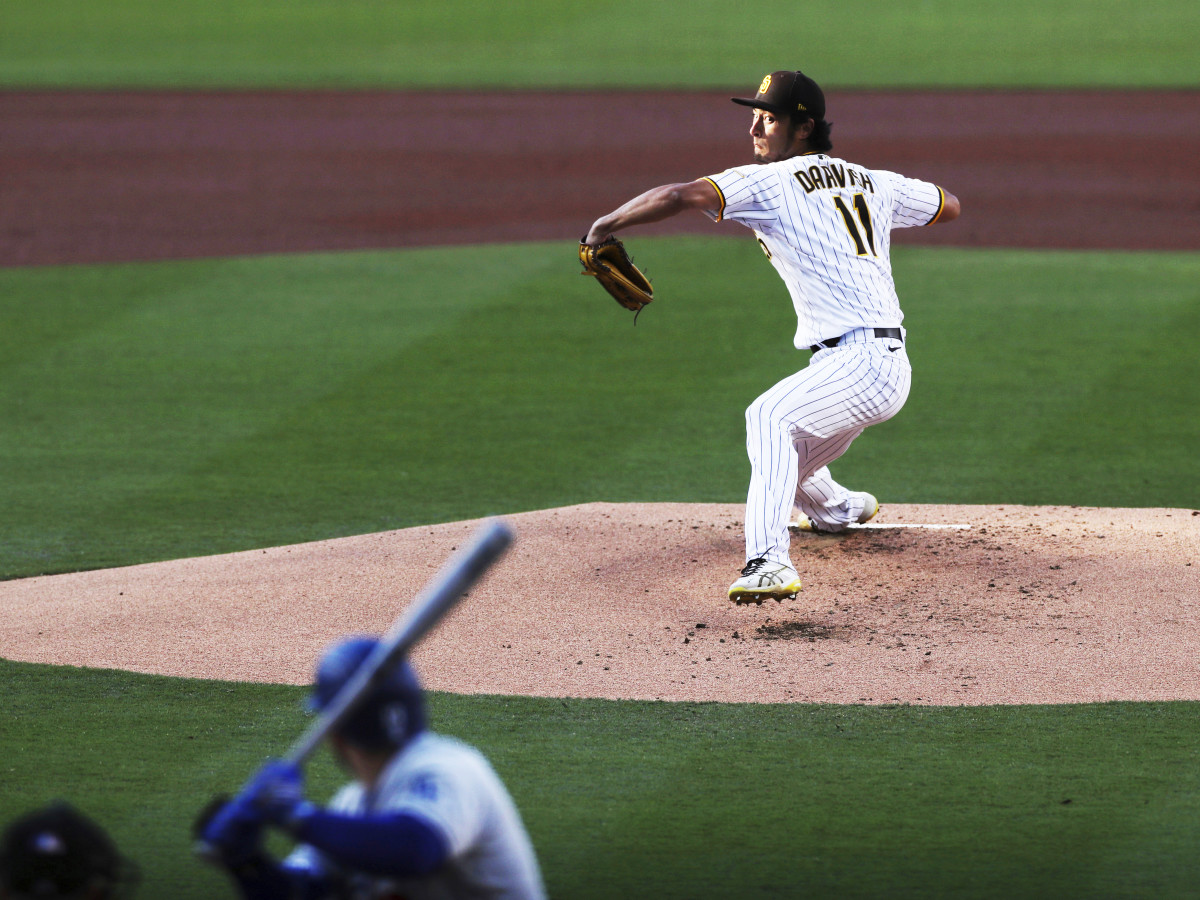What Is Pitching in 2022? It’s Padres Ace Yu Darvish, the King of Spin
Welcome to The Opener, where every weekday morning during the regular season you’ll get a fresh, topical column to start your day from one of SI.com’s MLB writers.
SAN DIEGO — On the precipice of disaster, Yu Darvish knew just what to do to save his start Saturday night. He would spin his way out of trouble. With the bases loaded, two outs and a full count to Mookie Betts of the Dodgers in the second inning, the Padres ace broke off an 88-mph cutter. Betts swung and missed. Starting with that pitch, Darvish threw only eight fastballs among his final 40 pitches. The Dodgers, the highest-scoring team in baseball, managed only one hit and no runs in six innings against Darvish as the Padres won, 3–2, in 10 innings.

That moment and that game define Major League Baseball in 2022. Three weeks in, the game looks like nothing we’ve seen before because:
• There are fewer hits in an average MLB game than ever before.
• For the first time in known history, secondary pitches are being thrown more than fastballs.
Spin is in, and Darvish is the King of Spin. Though Darvish can throw as hard as 97 mph, he throws a 60/40 mix of non-fastballs to fastballs.
“I think the biggest thing is that everybody who is here in the majors, or everybody who is playing baseball for that matter, they play the game because they love baseball,” Darvish says. “For me I love baseball because I really love to spin the baseball. I love to throw off-speed pitches. Growing up, that was my passion.”
Asked to describe his greatest joy on the mound, Darvish says, “When I have an off-speed pitch in my mind, and when I throw that pitch and it gets the reaction I want from the hitter. They are drawn away a little bit sometimes. That’s the reaction. And just being able to throw my off-speed pitch in a way that I want is something that I really enjoy.”
Darvish may have grown up loving off-speed pitches, but most pitchers today have come to learn that throwing fewer fastballs is the way forward. They are studying analytical charts and shaping spin in pitching labs to vex hitters. Tutored by coaches who did not pitch in the majors and trust data more than tradition, pitchers are following the information, and the information tells them hitters can hit even elite fastballs better than they can hit average spin. The old school way of “challenging” hitters with fastballs is dead.
The percentage of fastballs in MLB (not including cutters) had been steady until 2019. A rapid decline since then has dropped it below 50% this season for the first time in recorded history—down to 48.4%.

Six years ago, 28 of the 30 teams threw more than 50% fastballs. This year only eight teams throw fastballs with a majority of their pitches—and those eight teams playing by old school fastball standards are 49–76. Seven of those eight teams have losing records.
Throwing fewer fastballs is the secret sauce behind the Rays (38.7%, fewest in MLB for a second straight year), Dodgers (43.9%, second fewest) and Braves (44.7%, fourth fewest). It is why the Orioles’ pitching has vastly improved. They dropped their fastball use from 50.8% (18th) to 44.2% (third).
It is also true that average velocity is creeping up. That’s because more pitchers are bumping up against the limit of human capacity, not because individuals are pushing the ceiling higher. (You’re not going to see anyone throw a baseball 110 mph, for instance, but you are seeing more pitchers hit 100.) As elite velocity has become more common, hitters have adjusted to hit it. What they have not solved is spin, movement and change of speeds.
Why have secondary pitches become the primary choice this year? Follow the data. This snapshot of the last decade is as simple an answer as it gets:
MLB Batting Average vs. Pitch Types
Year | Fastballs | Non-Fastballs |
|---|---|---|
2013 | .276 | .226 |
2014 | .272 | .226 |
2015 | .278 | .226 |
2016 | .280 | .226 |
2017 | .279 | .228 |
2018 | .270 | .223 |
2019 | .276 | .227 |
2020 | .268 | .222 |
2021 | .265 | .223 |
2022 | .255 | .209 |
In a game of dwindling hits, home runs become even more important. And that’s also another reason why non-fastballs are proliferating: they are better at limiting homers. Fastballs make up 48.4% of pitches but 55.3% of home runs.
Power hitters are especially feeling the effects of the trend. San Diego’s Luke Voit saw 56% non-fastballs when he led the majors in home runs with the Yankees in 2020. Now he is seeing 66%—and hitting .071 against them.
In 2019, while Joey Gallo was still with the Rangers, he saw 49% non-fastballs and made the All-Star team. Now he sees 65% non-fastballs and is batting .129 against them. The Yankees left fielder has yet to homer.
Against the Dodgers Saturday night, Darvish threw two types of fastballs (four-seamer and sinker) and five types of secondary pitches (cutter, slider, split, curve and knuckle-curve). He finished the night with twice as many non-fastballs as fastballs (60–30).
Darvish may throw more types of secondary pitches than anyone, but his 60% season rate of non-fastballs is not close to the MLB lead. The leaders are the Brewers’ Corbin Burnes (92.7%, the majority being cutters and curves), Darvish’s teammate Joe Musgrove (62.8%) and the Rays’ Corey Kluber (62.5%). Burnes’s curveball is so nasty that hitters are 7-for-116 (.060) against it over the past two seasons.
Batters are hitting .181 overall against Darvish—including .082 in three starts if you remove a clunker at San Francisco. “The weather was too cold,” he says. “I couldn’t feel the baseball. Everything went in the middle.” Otherwise, he epitomizes why hitting is so difficult this season.
“He spins the baseball better than anybody I’ve ever seen,” teammate Sean Manaea says. “I would say he and Sonny Gray are the two guys I’ve played with who are on another level with what they can do with spinning a baseball.”
Says Musgrove, “So much of what he can do has to do with his feel for the baseball. It’s the difference between a pitching coach telling you to move your fingers in a certain way and having feel. With Yu it’s what it feels like and not what it actually looks like.
“For example, my slider thought is being on the side of the ball for as long as I can and letting the pronation of my hand take over. I let the pronation of my fingers be what spins the ball. He talks about directing the ball toward home plate while directing pressure into the side of the ball. So he pushes it out. It has the force of going out but it’s spinning in that direction. So he’s going to get that late sweep on it. So we get similar action but our thought process is way different.
“He’s super deep into everything he does. He’s into all these minor wrist position changes and little finger adjustments.”

For those without Darvish’s preternatural touch, the pitching lab works wonders. The Dodgers reshaped the breaking ball of 30-year-old lefty Andrew Heaney, for instance, by focusing on its spin properties to give it more sweep. After two starts before landing on the IL, Heaney is throwing more than 50% non-fastballs for the first time in his nine-year career. Batters are 2-for-20 against his revamped breaking pitch.
Watch MLB games online all season long with fuboTV: Start with a 7-day free trial!
Secondary pitches are not the only cause for why offense is down this month. Hitters didn’t get their usual plate appearances in a shortened spring training. Also, MLB expanded rosters from 26 to 29 through May 1 because of the lockout, and just about every team rushed to fill the spots with more pitchers. The result is more pitching changes and less fatigued pitchers.
“The third time through is real,” Dodgers manager Dave Roberts says, referring to how OPS for hitters increases as they face a starter a third time. “And so now when you take that out of the equation, now you have to play the matchups for the next 4 ⅓ innings. But then the cost ultimately is now you’re putting a lot of stress on your relievers. But now, when we are carrying an excess of relievers, there is no cost.
“When we get to May 2, when it’s going to be 13 pitchers, we’re going to have to kind of push starters more. … That’s where all the slug and ERAs for the starters go up. It doesn’t always have to, but that’s where you can taper back innings for the pen.”
If Roberts is right, offense will start to bounce back in May, which the game desperately needs. Coming out of the lockout with 16-man pitching staffs that suppress offense is not the way to build momentum. The 7.63 hits per team game this season is the lowest rate ever. But even comparing this month to all Aprils, rather than full season totals, the offensive numbers still are the worst in a generation or two (even with the DH in both leagues for the first time in April!):
• Batting average (.232) matches last April as the worst April since 1968, and the sixth lowest ever.
• Slugging (.368) equals the worst since 1981.
• OBP (.308) is the worst since 1968.
• OPS (.676) is the worst since 1981.
• BABIP (.283) matches last April as the worst in 30 years.
A limit of 13 pitchers per staff should help a bit to pull the game out of this offensive malaise. But the trend of emphasizing spin over fastballs is not going away. Darvish epitomizes what has happened to pitching. In his first seven MLB seasons, from 2012 to ’18, Darvish threw 50% fastballs. In the four seasons since then, he is throwing just 33% fastballs. With his stuff and the way he uses it in this modern game full of swings and misses, Darvish is not just the King of Spin. He also is the greatest strikeout pitcher through 216 career games (1,611) the game has ever seen.
More MLB Coverage:
• The Mets Rotation Is Thriving—And It Isn’t Even at Full Strength
• Five-Tool Newsletter: Ohtani, Pujols, Other Notes From the First Two Weeks
• Bud Black Is the Right Manager to Lead the Rockies to Their Peak
• Freddie Freeman Is Right Where He Belongs
• Inside the Mind of Juan Soto, MLB’s Best Hitter
Sports Illustrated may receive compensation for some links to products and services on this website.
